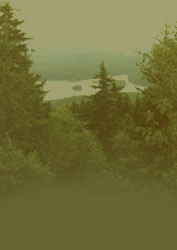|
Do you have something
happening in your corner of Washington? - Please call a member
or e-mail your observations to have them included here
November:
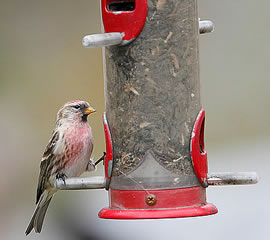
Picture found at: ebird.org
There are very few birds are coming to my bird feeders, what is going on?
Many homeowners have noticed that very few birds are coming to their backyard feeders. While this may seem concerning, there are some probable explanations. First, weather conditions can have a big impact on songbird behavior.
This fall has been an extraordinarily warm and mild and there is still plenty of natural food available in the landscape for wild birds. Food is particularly abundant in the natural landscape this fall. It was a prolific year for seed production for many plants. White pines produced an extraordinary amount of seed, which is an important food source for titmice, chickadees and nuthatches. With so much natural food available, songbirds are likely still out foraging instead of visiting bird feeders.
As the temperature drops and the snow begins to fly, expect to see the birds at your feeders again. To prepare, make sure your feeders are cleaned before winter. After several months of little use, seed that has been sitting out can become moldy and start to decompose. Not only is this seed unappetizing, but it can potentially make birds sick. Take apart your feeders and wash them with hot soapy water, and refill them with new, fresh seed.
Starting on November 11th, people who feed wild birds are encouraged to join “Project FeederWatch”, an initiative which helps scientists better understand bird populations and the many challenges facing birds. If you are concerned about the birds in your neighborhood, consider joining this citizen science project. Information about joining this is found here: Project FeederWatch
Audubon also has lots of information about backyard birding, information at: Audubon backyard birding and does a yearly backyard bird count, information at: Audubon Backyard Bird Count
The answer to the bird feeder question was provided by UNH Cooperative Extension Education Center. If you have questions, they can provide practical help finding answers for your gardening and lawn questions. You can call them toll free at 1-877-398-4769, M-F at 9am to 2pm or email them at answer@unh.edu
October:

Picture by Wallace Keck, National Park Service, found at NHPTV.org
Uh oh, SKUNK! Arin’s dog got sprayed by a skunk, making for an interesting early morning scramble to get rid of the smell!
Skunks are house cat-sized members of the weasel family native to North America. There are several types of skunks but the striped skunk is the most common in New Hampshire. It is mostly black with white on top of the head and neck and extending down the back, usually separating into two white stripes.
Skunks inhabit old fields, pastures, and woodland edges in rural and urban areas. They are nocturnal and become seasonally dormant in winter. They den in thick brush piles or woodchuck holes, and under decks and porches. Mating takes place during late February and early March, and an average of six blind and helpless young are born between late April and early June. About seven weeks later, the young begin to venture out with the female and are able to spray musk. Young skunks usually disperse during the fall of their first year.
Skunks are omnivorous but especially fond of insects, earthworms, small amphibians, mushrooms, small mammals, as well as fruits and nuts when seasonally available. They also will eat pet food and garbage if readily available. Skunks often damage lawns when they dig for grubs and insect larvae.
Skunks discharge their spray when frightened or attacked by pets and predators, interacting with other skunks, or when dying. The pungent odor is nauseating to many.
Here is some advice: If the spray affects your eyes or your pet’s eyes, flush with water for 10 minutes to relieve the discomfort. The spray won’t cause permanent damage, but it can sting painfully. Avoid rubbing the eyes.
If you find spray on your body or your pet’s coat, wipe it with paper towel first. Then mix 1 quart of hydrogen peroxide (3%), ¼ cup of baking soda, and 1 teaspoon of dish detergent in a bucket. Use an old washcloth to apply the solution to the skin, hair, or fur of the person or pet, avoiding the eyes, ears, and mouth.
If needed, re-apply the solution and rinse again. Use this mixture immediately. Do not store! Hydrogen peroxide does bleach, so if you’re concerned about lightening hair or fur, substitute white vinegar.
Should a skunk spray indoors, vent the building as much as possible by placing fans in open windows or doors to draw the odorous air out. Place boxes of baking soda around the area and be patient; the odor will dissipate with time.
Information on skunks found here:
Wildlifehelp.org
Information on what to do found here:
Mass Audubon
September:
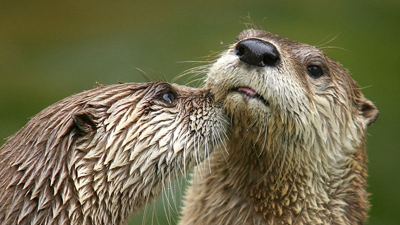
picture from wmur.com
Jed saw otters in the East Washington Pond recently. The are River Otters and they were swimming and fishing near the dam.
While fish make up the major portion of their diet, otters also prey on crayfish, frogs, small mammals, aquatic insects, turtles, water snakes and even eat some plant material like blueberries.
Masters of the waterways, otters are found in the moving water of rivers and streams as well as in marshes, ponds, lakes, and saltwater. The home range of an otter is typically 3-10 square miles, but may be as large as 60 square miles. A male otter has a larger territory that usually overlaps that of several females. Dens are used in raising the young and may be an old beaver lodge or bank den, a spot under the roots of fallen trees or in hollow logs close to water.
River otters are dark brown, fading to tan on the underside and on the muzzle and throat. Their coats consist of two kinds of fur – a dense, short, oily underfur and long, shiny guardhairs. Streamlined for swimming, with cylindrical bodies and long, tapering, round tails, otters are never far from water. Eyes, plus a flattened dark nose and small rounded ears are towards the top of the skull. Webbed feet greatly enhance an otter’s swimming abilities. Otters are related to mink, fisher, weasels and martens.
Otters have special adaptations for living in water that give them to ability to dive to a depth of 60 feet and stay underwater of up to three or four minutes. As they dive below the surface, otters automatically slow their heart rate and concentrate blood flow to the brain and vital organs, thus conserving oxygen. Valves in their ears and nostrils close to exclude water and a clear nictitating membrane (third eyelid) covers and protects the eyes while allowing for good vision. Whiskers two to four inches long are sensitive to underwater vibrations from prey.
Fun Facts!
• Otters can swim at six to seven miles per hour both above and below water.
• Otter slides? Yes, otters will slide down muddy, grassy or snowy slopes and these slides may be up to 25 feet long, usually ending in water.
• Otters are very playful, wrestling and chasing each other and rolling in the water.
• An otter’s fur is waterproof because the oily underfur is so dense and is structured in an interlocking pattern, keeping water away from the otter’s skin.
• Clean water is essential to otters so seeing one indicates a healthy waterway.
Information found here: Squam Lakes Natural Science Center
August:
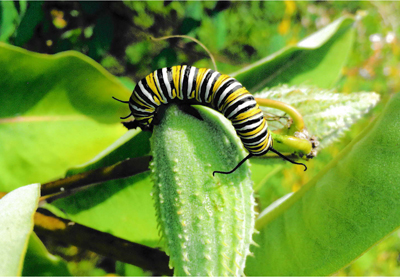
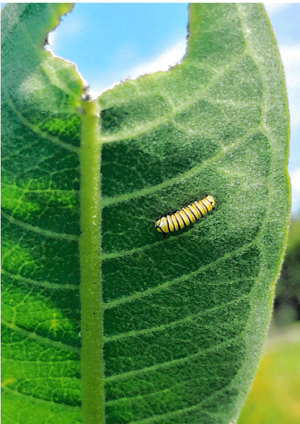
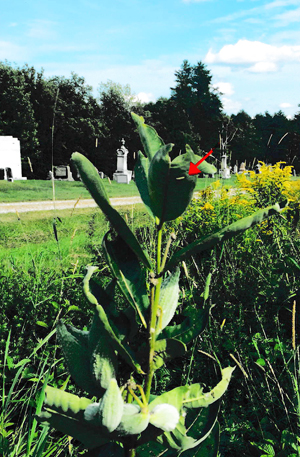
Monarch caterpillar pictures by Arin Mills
Arin found Monarch Butterfly caterpillars in the Washington Cemetery on Faxon Hill Road! We worked with the Cemetery Trustees and the Public Works Department to hold off mowing certain sections of the cemetery to give the pollinators a good chance to find nectar and things to eat. Success! The caterpillars were feeding on their favorite food - Milkweed, in the back corner of the cemetery. Our other pollinators - Bees, moths, insects and hummingbirds are also busy in the cemetery, visiting flowers, drinking nectarand pollinating.
Monarchs across their range have exhibited precipitous declines, from about a billion adults in 1996 to 56.5 million on their wintering grounds in 2015, a decline of about 94%. Habitat declines in both the US and Mexico have contributed to this. In Mexico, illegal logging has removed trees that the monarchs use for overwintering. In the US, increased herbicide use has reduced both foraging and milkweed habitat, and pesticide use causes direct mortality. In addition, drought and extreme weather has reduced foraging opportunities for both southbound and northbound butterflies.
Monarchs use a variety of habitats from meadows to edges of agricultural fields to gardens and anywhere else flowers are blooming that provide nectar sources for adults. Milkweeds are required for breeding, with eggs being laid on the underside of common milkweed and the caterpillars feeding exclusively on their leaves. Monarchs also pupate on milkweed plants. The third summer generation migrates southward, feeding on nectar throughout their journey to Mexico, where they overwinter on trees on one small section of mountainside forest. In 2015 all the monarchs from east of the Rockies ended up in a single, 3 acre patch of forest.
Monarchs in NH represent just a small percentage of the population. Habitat for this species is found along the edges of agricultural fields; however farming has declined over the last 100 years. Backyard pollinator gardens have been encouraged recently, and citizens are involved in some of the national citizen science projects such as Monarch Watch.
You can help the Monarchs by planting or preserving milkweed plants in your yard to feed the caterpillars and avoid using pesticides and herbicides. You can also feed the butterflies by planting a backyard pollinator garden to provide nectar.
Information found here:
NH Fish and Game
July:
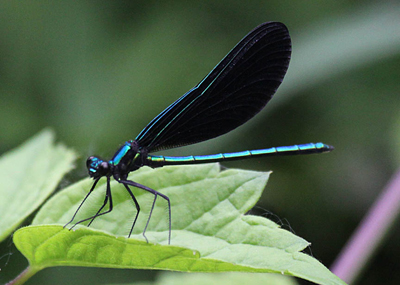
Ebony Jewelwing Damselfly, picture by Notdennis51
Johanna has been watching Ebony Jewelwing Damselflies near her pond. Damselflies are similar to dragonflies, but are smaller, have slimmer bodies, and most species fold the wings along the body when at rest. An ancient group, damselflies have existed since at least the Lower Permian age, and are found on every continent except Antarctica.
Brilliant, iridescent colors and interesting hovering flying style have made dragonflies and damselflies popular insects for years. Male damselflies typically have iridescent wings and some type of colorful blue, green, or purple body, while the females usually have a golden brown color, even on their wings. Both dragonflies and damselflies have two pairs of wings. These wings are thin and sheer, with small veins that crisscross to add strength. Damselflies rest with their wings together but not folded.
All damselflies are predatory; both nymphs and adults eat other insects. The matured Damselflies feed on mosquitoes, flies and other tiny insects. They often hover among low vegetations and grasses, eating the prey found on the leaves and stems by picking them with their thorny legs.
The nymphs are aquatic, with different species living in a variety of freshwater habitats including acid bogs, ponds, lakes and rivers. The nymphs moult repeatedly, at the last moult climbing out of the water to undergo metamorphosis. The skin splits down the back, they emerge and inflate their wings and abdomen to gain their adult form.
Their presence on a body of water indicates that it is relatively unpolluted, but their dependence on freshwater makes them vulnerable to damage to their wetland habitats.
Information found here: Wikipaedia - Damselflies and here: San Diego Zoo
June:
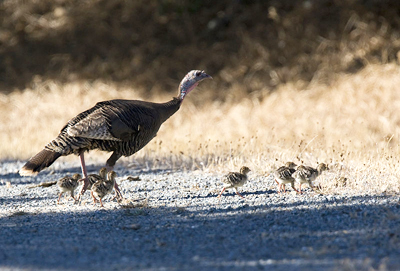
Picture by Kevin Cole, flickr
Arin wondered if we should be seeing wild turkeys with their poults right now and the answer is YES! I found an answer at "Something Wild" on NHPR, with 3 cool facts about Turkeys and their poults.
Springtime is a crucial time of year for New Hampshire’s 40,000 turkeys. After mating in April and incubating eggs in May, turkeys are now hatching chicks. A turkey hen lays one clutch of eggs per year, these clutches can as small as four to as large as 17 eggs per nest (that's a big clutch and that's cool fact #1)! The hen lays only one egg each day, so if she lays 14 eggs it takes two full weeks to lay the entire clutch. So even though egg 14 arrived two weeks after egg number one, they will al hatch at the same time, often within an hour of one another; it’s called “synchronous hatching” (cool fact #2)!
The hen doesn’t incubate the eggs (sitting on them to keep them warm) until she’s laid them all. Hens travel in a females-only flock, but they become more solitary and secretive in May when it comes to nesting. She’ll hang out with the flock and feed until she needs to lay an egg. Then she might hop over a nearby stone wall or move to some such remote place where she’s hidden her clutch on the ground. She lays the next egg, then gets up and returns to the flock.
But they keep a close eye on their nest. If someone or something gets too close, the hen will make an alarm call and make a big display of fleeing, this draws the intruder’s attention away from the location of the nest. So cold eggs in a turkey ground nest are uncovered and unheated. But unlike un-fertilized chicken eggs in your fridge, the embryos in these eggs will begin to develop once the hen starts incubating them. And four weeks later the eggs hatch.
But what walks out of those eggs aren’t chicks. Newly hatched turkeys are called poults, and here’s the difference. “Chicks” are hatchlings that are not yet mobile. Most birds, like songbirds and raptors, nest in trees. When their eggs hatch, the chicks are “altricial.” They are featherless and blind, squawking for food and warmth.
Poults, on the other hand are “precocial,” ready to run (cool fact #3). Turkeys and other ground nesters hatch-out with fuzzy feathers, open eyes and they soon can run. This is useful because turkey flocks (or “rafters”) cover a lot of ground in a day, and the poults have to keep up with mother hen as she leads them thorough her territory in search of food.
Where are all the male turkeys during all of this? After the mating season, “Toms” and younger “Jakes” retreat to a separate males-only flock, wandering around separate from the hens.
Information found here: Something Wild: 3 Cool Facts About Turkeys, by Andrew Parrella
May:
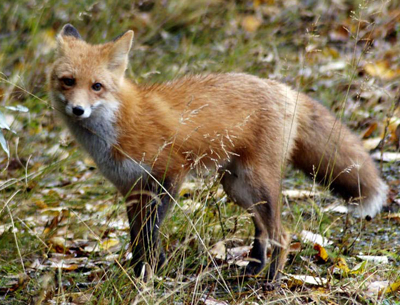
Picture found at NHPTV.org
For several days in a row, Jed saw a Red Fox run by the house with various food items including a small wild turkey, a large rodent and a red hen. He figured she had a den of kits somewhere that were waiting for a meal.
Red foxes are found throughout New Hampshire unlike their cousins, the grey foxes, which are found mostly in southern parts of the state.
Adult red foxes are usually solitary until mating season, which runs from January until early March in New Hampshire. Red foxes attract each other with series of nocturnal barking. Females have a gestation period of roughly 50 days and give birth to a litter of 1 to 10 kits (or pups) between March and May. One main maternity den is established, with a number of emergency dens prepared by the females. Families stay together in the dens until the kits disperse at seven months old (usually early fall). Males will travel up to 150 miles away, while females tend to stay closer to home.
Red foxes are often characterized as being cunning and in nature, because they exercise extreme caution and learn from experience quickly. Red foxes hunt primarily at night, feeding on vegetation in the summer, including corn, berries, apples, cherries, grapes, acorns and grasses, and on birds and small mammals during the winter. They also feed on invertebrates, such as grasshoppers, crickets, caterpillars and crayfish. Red foxes are cat-like when stalking prey, and their powerful legs allow them to reach speeds of 45 miles per hour. When foxes are full, they continue to hunt and store extra food in small burrows in snow, leaves and soft dirt.
Foxes are members of the canid, or dog, family, which includes wolves and coyotes. Canids tend to be quite vocal. High-pitched screams in the night that are often attributed to fisher cats are actually often noises from foxes.
During the cold New England winters, red foxes stay warm by growing a long winter coat. An adult fox rarely retreats to a den during the winter, but will instead curl into a ball in the open, using its bushy tail to wrap around its nose and footpads. Many times, they can be found completely blanketed in snow. With the onset of spring, red foxes shed their winter fur and prepare for warmer weather.
Red foxes live in extremely varied habitats, mixed cultivated and wooded areas and brushlands are perfect homes for this species, but they have been known to flourish in suburban neighborhoods and backyards. If you have a den on your property, do not worry – red foxes are usually harmless! Fish and Game suggests that they be left alone and outside pets, such as chickens, ducks, and rabbits, should be kept inside a sturdy fence to protect them from foxes.
Information found here:NH Fish & Game
April:
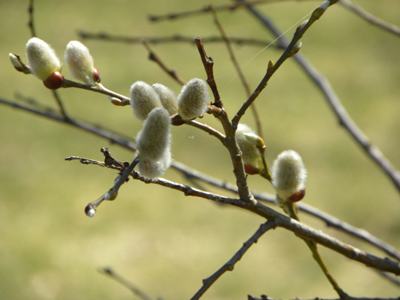
Picture found at Breck Hill Gardener
This month we talked about the First Signs of Spring we are all seeing. The following is a brief list of our observations. What are you seeing?
• Red Maple Trees budding
• Brooks running fast
• Small piles of old dirty snow, melting quickly
• Birds singing
• Geese and ducks returning
• Muddy roads
• Snow drops blooming
• Loons on the lakes
• Frost heaves
• Pussy Willows with catkins
• Robins
• Willow trees looking golden
• Slow wasps in the house
• Lambs in the barn
• Chipmunks running around
• Forsythia blooming
• Lady bugs
• Frogs and Salamanders crossing the road
• Bluebirds checking out nest boxes
• Daffodils
• Sprouts of green grass
• Peepers peeping
• Warm rain and mist in the hollows
• Green garlic sprouts in the garden
Enjoy the signs of spring all around you! Even if we see more snow, Spring has arrived!
March:
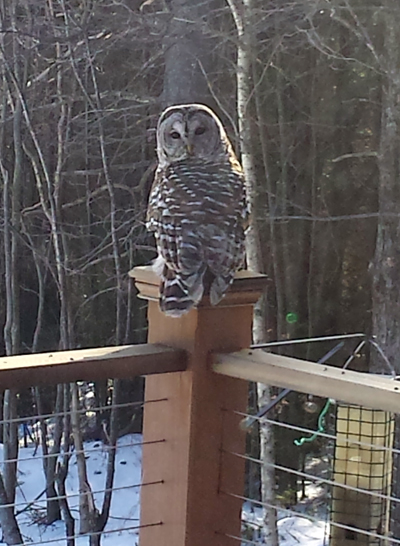
Picture by John Brighton
John has had a Barred Owl hanging around his deck and bird feeder lately and it is quite an impressive sight!
Barred owls are the most common owl in New Hampshire and is a year-round resident.
This owl is up to 21” tall and has a 43” wingspan. Dark bars across the chest feathers with dark streaks below. They have a round head, dark eyes, a yellow bill and no ear-tufts.
They live in mixed woodlands with large cavity trees for nesting and forest openings for feeding. They roost on tree branches and in tree cavities during the day and hunt at night by perching high up, watching and listening and then swooping down on prey. Though usually nocturnal, this time of year they are working overtime to find food, so we may see them during the day.
They can turn their heads 270 degrees when listening for prey. They hunt more by sound than sight, though their eyesight is very good. They can even hear a rodent moving under 2 feet of snow.
Their diet consists mostly of small mammals (i.e. mice, squirrels) and small birds, reptiles and amphibians, and invertebrates. Small prey are swallowed whole and larger prey are eaten in pieces starting with the head first.
Barred owl pairs raise one brood per year and probably mate for life. Nests are usually in a natural cavity 20-40 feet high with an opening 10-13 inches wide. They may also use abandoned stick nests made by squirrels, crows, hawks or other birds. Females lay 1-5 purely white eggs and incubate the clutch for 28-33 days. Hatchlings are covered with white down, have closed eyes, and remain in the nest for another 28-35 days.
They will often call and hunt on overcast days. In the winter, they might sunbathe along a woodland edge.
You may have heard this owl calling in the night, they make a series of hoots that sound like “Who cooks for you – who cooks for you all.”
Information found here:NH Fish & Game and NH Charitable Foundation
February:
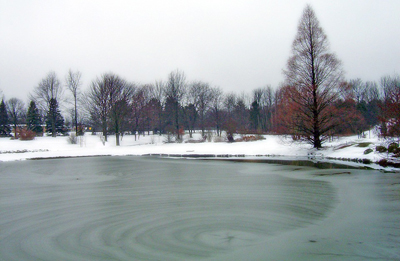
Picture found at MaxPixel
What causes strange noises to come from a frozen lake? Why would the ice make pinging sounds when rocks are thrown onto it?
The cracking or popping you hear from the ice often occurs when there’s been a temperature change. Lake ice is dynamic. Like any solid, it expands and contracts with temperature changes. The ice cracks, and sometimes you hear it—anything from grinding to a thunder-like boom. A build-up of snow on the ice or fluctuating water levels may also cause the surface to split. The cracks don’t necessarily mean the ice is weakening, even if the sound is unnerving.
And the chirping and pinging when you chuck rocks at the frozen water? They’re different from the noises you’d generate by whipping rocks at, say, dirt, because underneath the ice the water isn’t solid. Ice vibrates up and down, similar to a drumhead or cymbal vibrating after being struck. Different ice produces different sounds: A high-pitched noise when your rock hits the lake likely means you have “clear” ice. This is the glassy, see-through ice that’s formed under cold, still, non-snowy conditions. “Snow” ice—the opaque ice that forms after snow falls on the surface of the lake, becomes saturated with water, and then freezes—produces a lower-frequency sound, because fine grains in the ice absorb some of the noise.
Information found here:CottageLife.com
January:
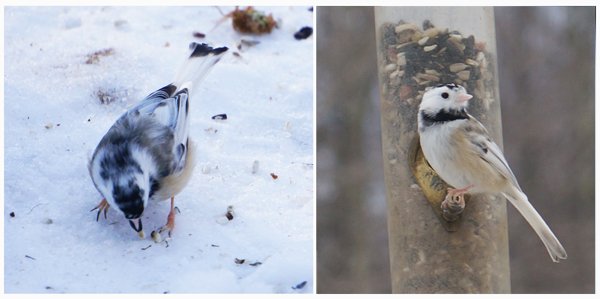
Picture by Jed Schwartz
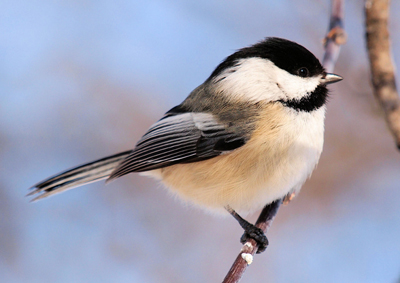
Black Capped Chickadee picture found at Indiana Audubon
What is that Bird?
Jed has had an odd looking bird visiting his bird feeder lately (see top pictures), it resembles a chickadee (lower picture, above) but has oddly placed white spots and a pinkish beak and legs. They have taken to calling the little mutant bird “Whitey”. In researching birds with abnormal coloration we found that it is rare but happens in several different forms and degrees. It turns out this bird was "Partially Leucistic" or "Pied" and not as rare as you might think.
The presence of white feathers on a normally dark bird is the most frequently seen color abnormality. Every birder can expect to encounter white or partly-white birds with some regularity, and the more striking examples will stand out even to novices.
All black and brown coloration in birds comes from melanin (of two types). Birds create melanin pigments using an enzyme, and this melanin is deposited in the growing feathers by color cells. At any stage and for many different reasons this complex process can break down, leading to a variety of conditions:
The True Albino
A full or true albino is a very specific mutation with a well known genetic cause similar across all vertebrates. These birds are unable to produce melanin at all. All of the plumage is white and the skin is unpigmented (pinkish).
Fully Leucistic
These birds can produce melanin, so the eye appears black, but something prevents them from depositing melanin in the growing feathers.
Partially Leucistic - Pied, partial albinism
This is probably the most commonly seen plumage abnormality in wild birds. This mutation is extremely variable in appearance, as birds can have just a few white feathers scattered on any part of the body, or whole sections of the body white, or the entire body white (fully leucistic, see above). The white feathers are often grouped in feather tracts, so that most of the head is white, or some of the wing coverts are white, or most of the tail, etc.
Dilute Plumage - Faded colors
Melanin of one or both types is produced and deposited in the feathers, but at low concentrations. The resulting pale gray-brown pigment is very susceptible to fading, and these individuals quickly become bleached by the sun. In dilute birds the relative concentrations of melanin on different feathers often remain the same as on normal birds, but all are much paler so the bird shows a faint “ghost” of the normal pattern.
And there are other variations, with other causes, too numerous to be mentioned in a brief overview such as this.
The coloration of birds is simple in some ways, and marvelously complex in other ways. Birds with abnormal plumage can be strikingly beautiful or just unusual-looking, and they can provide a fascinating deductive challenge as we try to figure out just what is going on.
Information found at: Sibley Guides
To view yearly archives of our "New In
Nature" series click on year you wish to see.
2002
2003
2004
2005
2006
2007
2008
2009
2010
2011
2012
2013
2014
2015
2016
|


